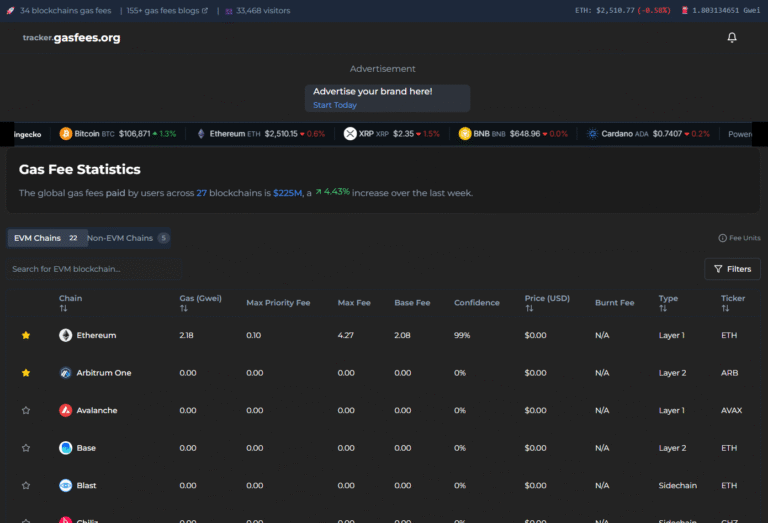
Understanding Optimistic Rollups Gas Fees: A Comprehensive Guide
Written By: Mr. GasMan
In the ever-evolving landscape of blockchain technology, the issue of gas fees has remained a persistent challenge. As blockchain networks strive for scalability and efficiency, Optimistic Rollups have emerged as a promising Layer 2 scaling solution. In this comprehensive guide, we will delve into the world of Optimistic Rollups and explore how they impact gas fees in blockchain transactions.
The Gas Fee Conundrum
Before we dive into Optimistic Rollups, let’s first understand the conundrum of gas fees. In blockchain networks like Ethereum, gas fees are essential for processing transactions and executing smart contracts. However, these fees can fluctuate significantly, making transactions costly during periods of network congestion.
The quest for solutions to high gas fees has led to the development of Layer 2 scaling solutions, and one of the most promising among them is Optimistic Rollups.
What Are Optimistic Rollups?
Optimistic Rollups are a Layer 2 scaling technique designed to enhance the scalability and cost-effectiveness of blockchain networks, with Ethereum being a primary focus. These rollups introduce an “optimistic” approach to transaction validation, aiming to reduce the need for extensive on-chain computation.
In an Optimistic Rollup, most transactions occur off-chain, in a separate environment called the “rollup chain.” The rollup chain periodically submits a summary of transactions to the Ethereum mainnet. This summary acts as a proof of the transactions’ validity without the need to execute each transaction on the mainnet, significantly reducing gas fees.
Optimistic Rollups and Gas Fees
Now, let’s examine how Optimistic Rollups impact gas fees:
1. Gas Fee Reduction
Optimistic Rollups dramatically reduce gas fees by moving the majority of transaction processing off-chain. Users can enjoy cost-effective transactions while still benefiting from the security and decentralization of the underlying Ethereum mainnet.
2. Scalability
Optimistic Rollups enhance blockchain scalability by reducing the computational load on the mainnet. This scalability improvement results in faster transaction confirmation times, making blockchain applications more user-friendly.
3. DeFi Applications
Decentralized Finance (DeFi) platforms often suffer from high gas fees on the Ethereum network. Optimistic Rollups offer a solution by significantly reducing transaction costs, making DeFi more accessible to a broader user base.
4. Smart Contracts
Smart contracts are a fundamental feature of blockchain technology. Optimistic Rollups ensure that executing smart contracts remains affordable and efficient, promoting the development of decentralized applications (DApps).
5. Interoperability
Optimistic Rollups are designed to be compatible with existing Ethereum-based applications and infrastructure. This means that users can seamlessly transition from the Ethereum mainnet to Optimistic Rollups to take advantage of reduced gas fees.
How Optimistic Rollups Impact Gas Fees
Optimistic Rollups employ a unique approach to gas fees. Here’s how they work:
- Off-Chain Execution: Most transaction processing occurs off-chain on the rollup chain, where gas fees are minimal or even non-existent.
- Batching Transactions: Optimistic Rollups batch multiple transactions together, reducing the number of individual transactions processed on the Ethereum mainnet. This batching reduces the overall gas fees for users.
- Fraud Proofs: To ensure security, Optimistic Rollups employ fraud proofs. These proofs allow users to challenge and verify any malicious activity, maintaining the integrity of the rollup chain without compromising security.
- Periodic Settlement: The rollup chain periodically submits a summary of transactions to the Ethereum mainnet. This summary ensures that the mainnet remains the ultimate source of truth, while the majority of transactions take place off-chain.
Applications of Optimistic Rollups Gas Fees
Optimistic Rollups have a wide range of applications within the blockchain ecosystem:
Payments
- Optimistic Rollups make blockchain-based payments more affordable and efficient. Users can send cryptocurrencies with minimal gas fees, opening up opportunities for microtransactions and everyday transactions.
DeFi Platforms
- Decentralized Finance (DeFi) platforms benefit significantly from Optimistic Rollups. Lower gas fees make it cost-effective for users to participate in activities such as trading, lending, and yield farming.
NFT Marketplaces
- Non-Fungible Tokens (NFTs) have gained immense popularity, but high gas fees on Ethereum can hinder their adoption. Optimistic Rollups provide a more economical environment for NFT transactions and minting.
Gaming
- Blockchain gaming often involves numerous in-game transactions. Optimistic Rollups make these transactions affordable, enabling blockchain gaming to reach a broader audience.
Decentralized Applications (DApps)
- DApp developers can leverage Optimistic Rollups to offer users a seamless experience with fast and cost-effective transactions. This encourages the growth of the DApp ecosystem.
In Conclusion
Optimistic Rollups represent a significant step forward in addressing the challenges posed by high gas fees in blockchain networks. By optimizing transaction processing, reducing costs, and maintaining compatibility with existing infrastructure, Optimistic Rollups are poised to play a pivotal role in shaping the future of blockchain technology.
As the blockchain space continues to evolve, the integration of Optimistic Rollups into various applications and platforms promises to enhance user experiences, drive innovation, and make blockchain technology more accessible to a global audience. With lower gas fees, increased scalability, and improved efficiency, Optimistic Rollups are set to revolutionize the blockchain industry and pave the way for broader adoption.
Share this blog:
Trezor Safe 5
Why Use GasFees.org? 🛠️
📊 Real-Time Data: Get accurate gas fee updates anytime.
🌍 All Blockchains: Layer 1 and Layer 2 covered in one place.
💸 Save Money: Optimize transactions with our insights.
🔍 Easy to Use: Designed for beginners and experts alike.

 Real-Time Gas Fees Tracker!
Real-Time Gas Fees Tracker! 










